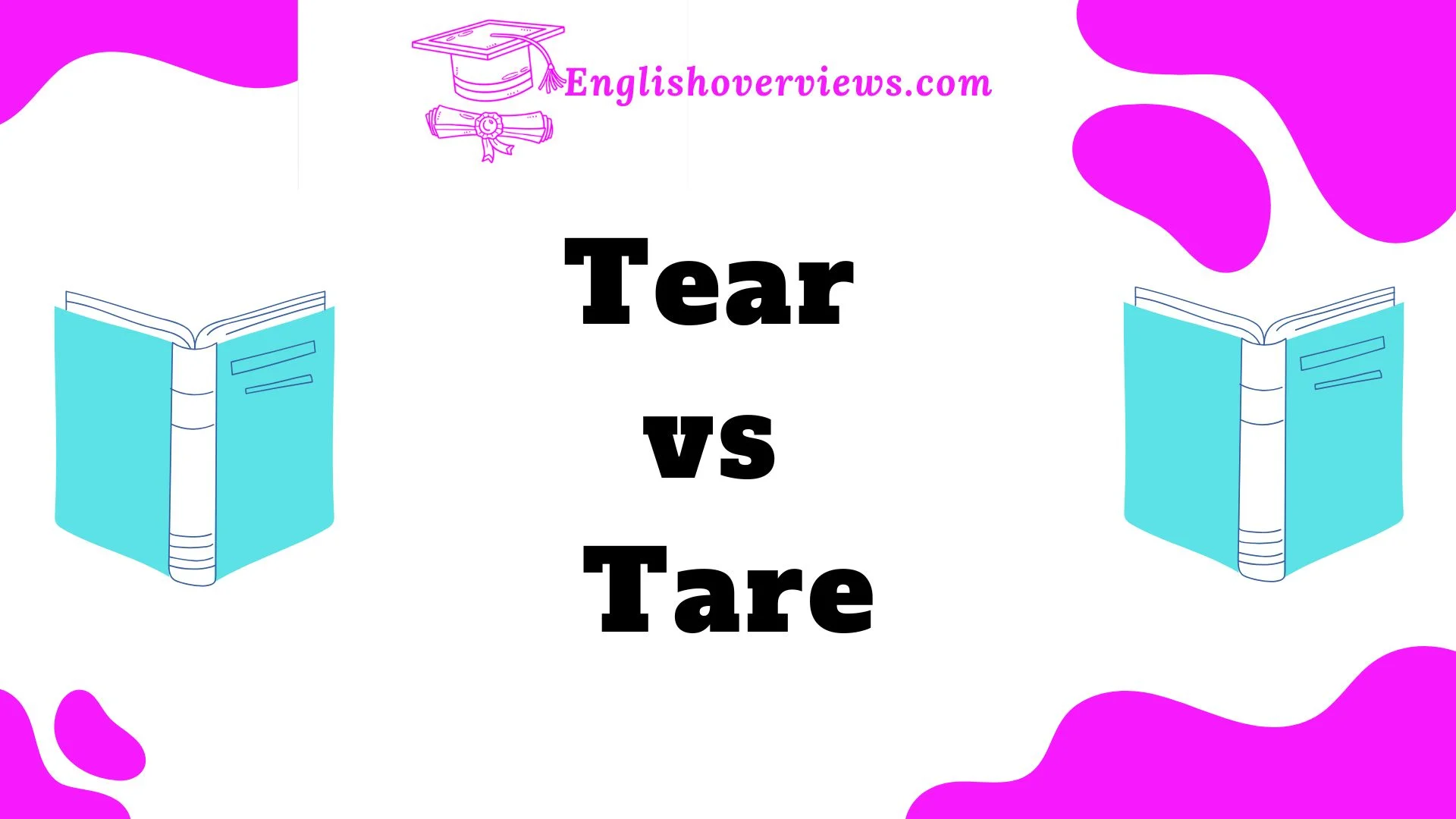Homophones can trip us up even when we know our language well. Two common words that often cause confusion are tear and tare. While they sound identical, they have very different meanings and uses.
In this blog post, we’ll break down these words in detail, explain when to use them, and give you memory tips to help you avoid the common mistakes people make with tear and tare.
By the end of this post, you’ll not only have a clear understanding of the differences between tear and tare, but you’ll also be armed with real-world examples, simple tips, and a few tricks to make sure you never mix them up again. Let’s dive right in!
What is a Homophone?
A homophone is a word that sounds the same as another word but has a different meaning and usually a different spelling. Homophones can make writing tricky, as one wrong choice can change the entire meaning of a sentence.
For example, tear and tare are homophones. Both words are pronounced the same, but their meanings are completely different. In the English language, there are many homophones like this, including flower and flour, or bare and bear.
Now, let’s take a closer look at each word in detail.
The Word “Tear” – Definitions and Meanings
The word tear has two main meanings, both of which are very different from each other. Let’s explore these in detail.
“Tear” as a Verb
When used as a verb, tear refers to the action of ripping or pulling something apart, often forcefully. This is one of the most common uses of tear.
- Example sentence: “She accidentally tore the paper while wrapping the gift.”
- In this context, tear is the act of physically breaking or damaging something.
“Tear” as a Noun
As a noun, tear refers to the drop of salty fluid that comes from your eyes, typically in response to emotions such as sadness, joy, or even irritation.
- Example sentence: “A tear fell down his cheek when he heard the news.”
- Here, tear is a small droplet produced by the eyes during emotional moments.
Quick Summary of “Tear”
| Part of Speech | Meaning | Example |
| Verb | To rip, destroy, or damage | “I accidentally tore my favorite shirt.” |
| Noun | A drop of liquid from the eyes | “Her eyes were filled with tears.” |
The Word “Tare” – Definitions and Meanings
Unlike tear, tare is a less common word, but it plays an important role in specific contexts like weighing or packaging. Let’s break it down.
“Tare” as a Noun
In its noun form, tare refers to the weight of a container or packaging that is not included in the total weight of the contents. In other words, it’s the weight that needs to be subtracted from the overall weight to get the actual weight of the item inside.
- Example sentence: “The tare weight of the box was 2 pounds, so the contents weighed 8 pounds.”
- This is commonly used in shipping, packaging, and grocery stores.
“Tare” as a Verb
As a verb, tare means to subtract the weight of the container to determine the net weight of its contents. This is often done when weighing produce or other items that are sold by weight.
- Example sentence: “The cashier tared the scale before weighing the tomatoes.”
- In this case, tare refers to adjusting the scale to account for the weight of the container before measuring the item inside.
Quick Summary of “Tare”
| Part of Speech | Meaning | Example |
| Noun | The weight of packaging or a container | “Subtract the tare from the total weight.” |
| Verb | To subtract the weight of packaging | “They tared the scale before weighing.” |
Common Confusions – Why “Tear” and “Tare” Are Often Mixed Up
Let’s take a look at why these two words are so easy to confuse, despite their very different meanings.
Pronunciation
Both tear and tare are pronounced exactly the same. This makes it easy to mix them up in both speaking and writing. So, if you’re saying these words aloud, you wouldn’t even notice the difference!
Visual Similarity
The words tear and tare are also visually similar, sharing a similar structure. When written down, they may look almost identical, especially when you’re in a hurry. This can lead to confusion, particularly for those who rely on visual cues for spelling.
Contextual Confusion
The most significant reason people mix them up is because they’re used in similar contexts. For instance, in cooking, you might tare the scale to weigh your ingredients, but in the same breath, you might also tear a piece of paper to write down the recipe. The same goes for the emotional use of tear, which might appear in situations where you’re handling tare weight in packaging.
Practical Examples: Using “Tear” in Sentences
Now that we’ve explored the meanings, let’s look at more practical examples to cement these uses.
- Tear as a verb: “I’m careful not to tear the fabric when I’m stitching it.”
- Tear as a noun: “She wiped away a tear from her cheek after watching the heartfelt movie.”
More Examples of “Tear”
- Verb: “He tried to tear open the envelope but couldn’t find the edge.”
- Noun: “A single tear glistened in her eye as she said goodbye.”
Practical Examples: Using “Tare” in Sentences
Let’s now look at how to use tare correctly in writing.
- Tare as a noun: “The store clerk subtracted the tare weight of the basket from the total weight of the fruit.”
- Tare as a verb: “Before weighing the flour, the baker made sure to tare the scale.”
More Examples of “Tare”
- Noun: “The tare on the box was 3 pounds, so the total weight of the shipment was 15 pounds.”
- Verb: “He had to tare the balance scale before weighing the ingredients for the recipe.”
How to the Difference Between “Tear” and “Tare”
Here are a few easy tips to help you remember when to use tear versus tare:
- Tear = Emotion or Destruction
- Think of tears in your eyes or tearing a paper. Both are associated with action or emotion.
- Tare = Weighing and Containers
- The word tare is related to weight. Think of a tare weight as the weight of a container that you need to subtract when weighing something.
- Visual Mnemonics
- Tear has an “E” like emotion or eye (relating to the tears in your eyes).
- Tare has an “A” like amount or arithmetic (used in weighing things).
Real-World Applications of Tear vs. Tare
Both tear and tare are commonly used in specific scenarios. Here are a few real-world examples of where you might encounter them:
- Tear in everyday life:
- Emotional situations: “She couldn’t hold back the tears after watching the touching video.”
- Physical actions: “The kids tore apart the wrapping paper during the gift exchange.”
- Tare in commercial settings:
- Weighing items: “The cashier tared the scale before weighing the produce.”
- Packaging and shipping: “The tare weight of the shipment was removed to calculate the final cost.”
FAQs:
Q: Why do people confuse “tear” and “tare”?
A: The primary reason people mix these words up is because they sound the same but have different meanings. The context is often what determines which word to use.
Q: Can I use “tear” to describe something that isn’t emotional?
A: Yes! While tear is often associated with emotions, it can also mean ripping or damaging something, such as tearing paper or fabric.
Q: Is “tare” used in daily life?
A: Yes, particularly in situations involving weight, such as grocery shopping or shipping, where the weight of containers is subtracted.
Conclusion
Now that you know the difference between tear and tare, you can avoid the confusion that many people face when writing or speaking. Remember, tear relates to emotion or destruction, while tare deals with weight and containers. With these tips, you should be able to use both words correctly in any situation!
This article has covered tear vs. tare in-depth, helping you understand the differences and providing practical tips to remember them. With real-world examples and helpful mnemonic techniques, mastering these homophones should be a breeze!

Alyan Ashraf is the creative mind behind English Overviews, a platform dedicated to helping learners master the English language. Passionate about education and language development, Alyan specializes in simplifying complex English concepts, making learning accessible for students of all levels.











